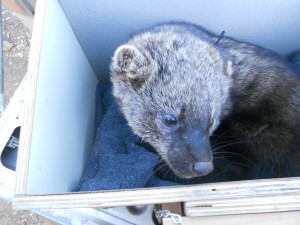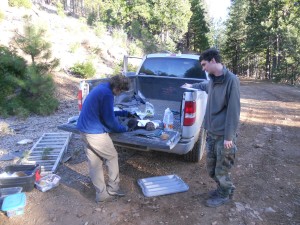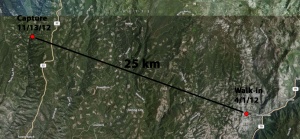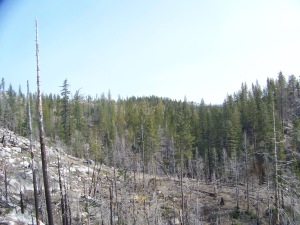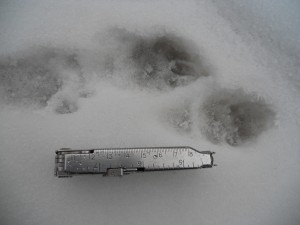Fishers, like most mustelids, are predators. Unfortunately, the food available to them versus what they kill and eat are often unknown to researchers. We have dedicated a good chunk of our summer trying to understand better what is available for fishers to eat compared with what they actually select on our study site. This summer we had several folks out trapping and documenting potential prey species for fishers across the Stirling district. Many people were involved but we had three excellent field crew out there doing most of the work. Alex, Erika, and Jesse (see their lovely photos below) were out most days setting and checking traps in diverse types of cover and tree stand types. The point of all this is to attempt to understand where specific types of prey are found on the landscape based on differences in the environment and forest management practices.
We are just starting to examine these data to document and explore specific patterns of occupancy and distribution for different prey species. Nevertheless, we encountered many different species of mammals, birds, and herpetofauna (snakes and lizards mostly) across the landscape thru the summer. We captured deer mice (Peromyscus spp.) just about anywhere we set traps, and woodrats (Neotoma spp) also occupy diverse land covers types. We do not catch them as often as deer mice, but they are still abundant. The crew also captured ground squirrels (Otospermophilus beechyii), Douglas squirrels (Tamiasciurus douglasii), various chipmunks, and even hapless ringtail (Bassariscus astutus). While setting and checking traps they also kept an eye out for lizards and snakes. A few of the snakes were of the venomous variety (rattlesnakes) as well as snakes that are not quite so dangerous but just as cool. Alligator lizards and fence lizards also seem to be in lots of places as well. Other types of potential prey species like gray squirrels, black-tailed jack rabbits and flying squirrels were also noted but seem to be harder to capture in live-traps.
Of course, when you put a lot of fresh peanut butter and oats out in a forest you get other critters that are interested. Bears are a common visitor and they are usually unconcerned with maintaining the integrity of our trapping grids. They move, turnover, often destroy, and at other times even steal traps! Bears are one of our nemeses both when doing this kind of work and just about everything else (they are everywhere). We also see foxes and occasionally we even see a fisher wander across a trapping grid.
The crew is primarily taking data on where we capture specific types of animals. They also document the sex and relative age of each species, measure the weight, examine them for ectoparasites and give them marks and tags so we can document which individuals we have recaptured. We are also collaborating with Deana Clifford and the Wildlife Investigations Lab to evaluate some captured animals for rodenticides and diseases. All these data are important to future analyses and monitoring.
Vegetation types are also important and we
collect information on the number of trees and shrubs that occur on each trapping grid. Sometimes the crew accidently document other species of plants. They often don’t’ know this until a day or two later when they realize they have a poison oak rash and then must bear the burden of scratching and itching for several days. It’s a badge of honor. We all wear it proudly at one point or another – except for those people lucky enough not to be affected (we are all looking at you Jesse) – if not without a large degree of annoyance.
Good times were had by all and more importantly we have collected new and interesting information that will help us conserve and manage fishers and fisher forests.

